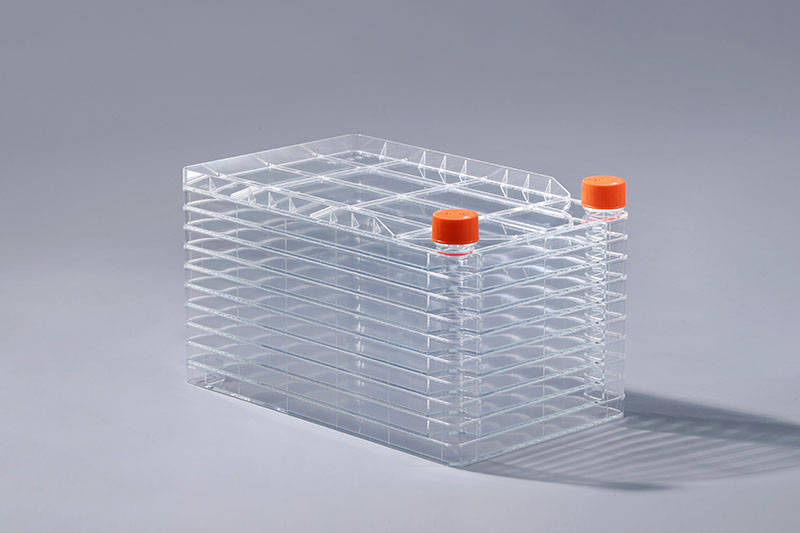je potrošni material večplastne celične kulture, ki se večinoma uporablja v industrijski množični proizvodnji, laboratorijskih operacijah in obsežni celični kulturi in je idealna izbira za adherentne celice. Pri izbiri tovrstnega potrošnega materiala bomo pozorni na ključni dejavnik, to je površinska TC obdelava, zakaj mora biti podvržena tej posebni obdelavi?Celice lahko razdelimo na dve vrsti: adherentne celice in suspenzijske celice po različnih rastnih metodah. Za rast suspenzijskih celic ni treba pritrditi na podlago in lahko rastejo v suspenziji v gojišču. Adherentne celice morajo imeti rastno površino, na katero se lahko pritrdijo, da rastejo, in samo hidrofilni trdni vmesnik lahko omogoči pritrditev celic.cell factory
Tovarna celic se uporablja predvsem za kulturo adherentnih celic, ki se predela z brizganjem surovine iz prozornega polistirena (PS). Kot polimerni material ima PS dobro trdnost in plastičnost ter nima strupenosti in je postal prednostni material za potrošni material celične kulture za enkratno uporabo. Vendar je površina PS hidrofobna, kar sama po sebi ne spodbuja rasti adhezivnih celic. Za izboljšanje adhezivnosti celic je potrebno obdelati površinsko modifikacijo in uvesti hidrofilne skupine, da celicam omogočimo boljšo rast.
Če povzamemo, je namen obdelave TC na površini celične tovarne prilagoditi se rast adhezivnih celic. Potrošni material, ki se uporablja za suspenzijsko celično kulturo, ne zahteva nujno tako posebej obdelanih posod, vendar je potrošni material po površinski obdelavi TC na splošno primeren tudi za kulturo suspenzijskih celic.
In summary, the purpose of TC treatment on the cell factory surface is to adapt to the growth of adherent cells. The consumables used for suspension cell culture do not necessarily require such specially treated vessels, but the consumables after surface TC treatment are generally also suitable for the culture of suspension cells.
The FAI climbed 5.9 percent year-on-year in the first 11 months of 2018, quickening from the 5.7-percent growth in Jan-Oct, the National Bureau of Statistics (NBS) said Friday in an online statement.
The key indicator of investment, dubbed a major growth driver, hit the bottom in August and has since started to rebound steadily.
In the face of emerging economic challenges home and abroad, China has stepped up efforts to stabilize investment, in particular rolling out measures to motivate private investors and channel funds into infrastructure.
Friday's data showed private investment, accounting for more than 60 percent of the total FAI, expanded by a brisk 8.7 percent.
NBS spokesperson Mao Shengyong said funds into weak economic links registered rapid increases as investment in environmental protection and agriculture jumped 42 percent and 12.5 percent respectively, much faster than the average.
In breakdown, investment in high-tech and equipment manufacturing remained vigorous with 16.1-percent and 11.6-percent increases respectively in the first 11 months. Infrastructure investment gained 3.7 percent, staying flat. Investment in property development rose 9.7 percent, also unchanged.
 English
English



















































